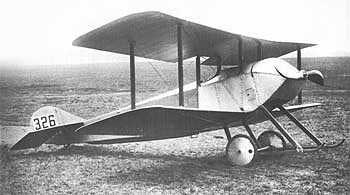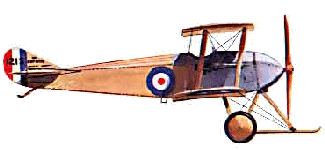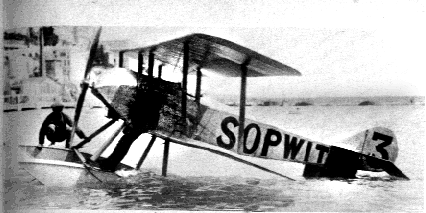|

The
Sopwith Tabloid was constructed in 1913 as two-seater racing aeroplane.
The design was one of extreme simplicity. The engine was the popular 80
h.p. Gnome rotary enclosed in a peculiar metal cowling, with two small
cooling slots in front. The fuselage, a wire-braced woods box girder,
was rather broad, for the pilot and passenger sat side by side in the
one cockpit. The wings were of usual fabric-covered wooden
construction, with raked tips. Wing warping was used for lateral
control. The undercarriage was equipped with twin skids.
Flown
by Harry Hawker, the Tabloid performed excellently on test at
Farnborough. reaching a speed of 92 m.p.h and climbing to 1,200 feet in
one minute, with pilot. passenger and fuel for two and a half hours'
flying. Its first public appearance at Hendon was sensational; it
easily outclassed the monoplane, which had hitherto been supreme.
The
original machine was taken by Hawker to Australia- he returned in June
1914; by then the aeroplane had a plain vee undercarriage and the
fabric had been removed from the rear end of the fuselage.
On
April 20th, 1914, Howard Pixton, who had take
over Hawker's duties, piloted a seaplane version of the Tabloid to
victory in the Schneider Trophy race. This model had the 100 h.p. Gnome
Monosoupape engine and plain rudder and fin.
Production commenced in the spring of 1914 for both the R.F.C. and
R.N.A.S. The service machines were single seaters, had rudders and fins
resembling those of the Schneider seaplane, and twin-skid
undercarriages. A few had extra bracing struts to each skid.
Four
Tabloids went to France shortly after the outbreak of war, and were
eventually attached to squadrons for fast scouting duties. An early
success was obtained by Lieutenant Norman Spratt, who forced down a
German machine by circling his Tabloid around it; his only 'armament'
at the time being a bundle of steel darts! Some R.N.A.S. machines had
Lewis guns fitted on their top wings to fire above the revolving
airscrew. One naval Tabloid had a Lewis gun fixed on the starboard side
of its fuselage to fire through the airscrew arc; deflector plates
protected the blades from damage-a device invented by the French
engineer Saulnier and used on the single-seater Morane Saulnier
monoplane.
The
type scored its greatest success in the light bomber role. On October
8th, 1914, the first two R.N.A.S. Tabloid' to reach the front, Nos, 167
and 168, took off from beleaguered Antwerp to raid the Zeppelin sheds
at Cologec and Dusseldorf. Squadron Commander Spenser Grey, flying 167,
was unable to find his target, and bombed the railway station at
Cologne, flight Lieutenant Marix dropped his 20 lb. bombs on the
airship shed at Dusseldorf and destroyed the new Zeppelin Z.IX. Both
aeroplanes were forced to land, but the pilots reached Antwerp before
the town was evacuated by the Allies.
Later
machines had ailerons for lateral control, In place of wing warping. It
is believed that about forty of the type were built.

A
specially modified Sopwith Tablid
was the winner of the Schneider Trophy race, in 1914. alterations
consisted of the addition of two floats and a more powerful engine. On
April 20, 1914. at Monaco, Howard Pixton flew an average of 86.9 mph
(39.6 kph). In two extra laps, he reached 92 mph (148 kph).
establishing a new seaplane speed record. Thus the Sopwith biplane had
its revenge on the Deperdussin monoplane and gave Great Britain its
first major international success in aviation.
The special version of this plane prepared for Britain's first
appearance at the Schneider Trophy was not substantially different from
the model that had appeared the previous autumn. The land version of
the Tabloid was designed by T. O. M. Sopwith and F. Sigrist. as a
demonstration and
racing aircraft. It was built in great secrecy, and preliminary tests
were made at Brooklands in autumn 1913. These
were followed by the official evaluation tests, and the plane
immediately demonstrated its speed and manoeuvrability.
At the Royal Aircraft Factory at Farnborough, where the tests were
conducted, the Tabloid reached a top speed of 92 mph (148 kph) in
horizontal flight and showed a rate of climb in the order of 1,200 feet
per minute (365.75 metres per minute). The same day, November 29, test
pilot Harry Hawker flew the plane to Hendon, where one of the popular
Saturday air meetings was being held. The new Sopwith was seen by more
than 50,000 spectators, and flew two low-altitude laps round the course
at more than 87 mph (140 kph). After that, the plane was ordered in
large numbers by the army and the navy as a
single-seater reconnaissance aircraft.

Then the Sopwith company readied one of its single-seaters for the
upcoming Schneider Trophy race. Since the race was restricted to
seaplanes, the aircraft had to be modified. The landing gear was
removed, and a large central float was installed in its place. The
100-hp Gnome engine was also modified for the occasion. The single
float did not stand up to tests, the plane capsizing. There was very
little time left before the race, so the Sopwith designers decided to
slice the original float in half to make two new ones. This time flight
and landing tests on the Thames were successful, and the Tabloid was
sent off to Monaco on April 8, 1914. The final modification before the
race was the installation of a better propeller. The rest is history.
Back in England after the race, the floats were removed at Sopwith's
factory at Kingston-on-Thames, and a V strut landing gear was
installed. Now the plane was ready for R. H. Barnwell to fly at the
1914 Aerial Derby. But because of poor visibility the plane did not
complete the race. That was the end of the Tabloid's racing career. War
broke out, and the Tabloid served as a reconnaissance plane during the
first months of the conflict, when its speed and general handiness
became very useful military assets indeed

An
unarmed single-seater, it was one of the first British biplanes to be
used in combat. On the afternoon of 9 October 1914, in the first
successful bombing mission of the war, the Royal Naval Air Service sent
two Tabloids to attack the Zeppelin sheds at Dusseldorf and Cologne.
Only one of them reached its target but Zeppelin Z-9 was destroyed in
its shed at Dusseldorf when the Tabloid pilot released two 20 pound
bombs from a height of about 600 feet.
Country: Great Britain
Manufacturer: Sopwith Aviation Company
Type: Reconaissance/Bomber
First Introduced: 1913
Number Built:
Engine: Gnôme Monosoupape, rotary, 100 hp
Wing Span: 24.9 ft [7.49 m]
Length: 22.8 ft [6.95 m]
Height:
Empty Weight:
Gross Weight: 1,578 lb [716 kg]
Max Speed: 92.5 mph
Ceiling:
Endurance:
Crew: 1
Armament: 40 lb of bombs |
